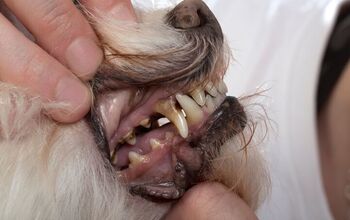Clumber Lab


About Clumber Lab
The beautiful, sturdy Clumber Lab is a hybrid that comes from exceptional stock; the gentle Labrador Retriever and the impressive Clumber Spaniel. Both were originally bred for sport, which means you have a dog who loves to be active, but is highly obedient, keen-to-please and therefore easy to train. While the Clumber Lab will require regular exercise, it won’t be excessive and can be easily managed by an older child who is trained on how to properly handle a dog on a leash. If there is a downside to this fantastic little fur-kid, it would be that he may have inherited the Clumber spaniel’s tendency to snore and to drool.
The Clumber Lab is a hybrid of Labrador Retriever and Clumber Spaniel.
Clumber Labs are a new hybrid gaining in popularity given the calmer, gentler personalities of their parent breeds. The Clumber spaniel was first developed as a hunting dog in the United Kingdom and is the largest of the spaniel breeds. His shorter stance, broad chest and light to white color made him ideal for moving through heavy brush to fetch prey. Though exact dates differ, rumor has it he was a favorite of Prince Albert (Mr. Queen Victoria) back in the 19th century. Labrador retrievers hail from 19th century Newfoundland, Canada and were used by fisherman to haul nets, ropes and pull in fish. Brought in to support that industry in Dorset, England, British nobles soon noted the dog’s stamina, water and retrieving skills and began using them in hunting waterfowl.
The Clumber Lab is a hybrid and therefore is unable to join the American Kennel Club’s (AKC) roster of purebreds. Both parent breeds however, are long-time members of the AKC dating back to 1884 when the Clumber spaniel first gained recognition and joined the elite club’s “sporting” group and 1917, when the Labrador retriever was also admitted into AKC’s “sporting” group.
The Clumber Lab is considered medium-sized, which means you should expect him to consume 2-2.5 cups of dry food each day. As he comes from “Labrador” stock, over-eating can be a problem as it leads to obesity; don’t plan to free-feed your dog. Meals should be spaced over two feedings and food type should be geared specifically to the size, weight, age and activity level of your dog. Be sure to avoid fillers such as carbohydrates and grains that will cause him to eat more in order to feel full. Opt for ingredients that indicate “meat” as a first ingredient and because he may be prone to hip dysplasia and joint issues, foods that include glucosamine are a good option.
The Clumber Lab loves being part of family activities.
Because the Clumber Lab is a highly intelligent dog, training him in both obedience and socialization should be easy to accomplish for even a first time dog owner. That said, the Clumber Spaniel is known to be a bit independent which means that in addition to training your dog in a positive, rewards-based manner, you will need to be patient and consistent to ensure he understands that you are the pack leader and he needs to heed your commands.
The Clumber Lab is considered a medium sized breed and when fully grown, he will weight 55-85 pounds depending on whether you have a male or a female.
The Clumber Lab is described as being loyal, affectionate and gentle. He loves being part of family activities and will settle in nicely with children of all ages as well as other dogs or small pets. The retriever side of him means that he will always be up for a game of fetch or a swim, and because spaniels tend to be of a not-quite-so-active nature, he is equally comfortable relaxing indoors with his human pack. He can be a bit wary of strangers – which means socialization training is important – however is not prone to barking and will only do so if he feels it is warranted.
Clumber Labs have no known health problems however pet parents considering any hybrid dog should be sure to look to the parent dogs’ lineage for clues to potential illnesses. Labrador retrievers can suffer from hip and elbow dysplasia as can Clumber spaniels who are also prone to eye problems including cataracts and dry eye.
The Clumber Lab has a life expectancy of 10 to 14 years.
The Clumber Lab is an active dog, however not what one would consider “high energy”. Although they love to play active games, a romp in the yard is not sufficient to keep this dog healthy. He will require a good long daily walk to keep him in shape, mentally stimulated and therefore out of trouble.
The Clumber Lab is described as being loyal, affectionate and gentle.
As a hybrid, the Clumber Lab is not recognized by the American Kennel Club however he is a member of the Dog Registry of America, Inc. (DRA).
The Clumber Lab is a moderate shedder and tends to shed year-round versus cyclically. Weekly brushing should be sufficient to keep the hair in check and grooming to trim excess hair on his ears, feet and between the pads is recommended. Because this breed has floppy ears, infections can occur so ears should be checked and cleaned regularly to avoid a buildup of wax and debris.
Clumber Lab pups grow quite rapidly and are extremely active. Because of this breed’s propensity to joint and bone issues, owners should avoid the urge to over-exercise him in order to tire him out. Watch and respond to his body language to avoid injuries that may plague him later in life. Food should be provided over several meal-periods, versus left in the open, and plenty of chew toys will help quell his need to gnaw on everything in sight.
Photo credit: Anna-Li Naucler/Flickr

Sharing space with three seriously judgy Schnoodles and a feline who prefers to be left alone. #LivingMyBestLife
More by Mary Simpson
























